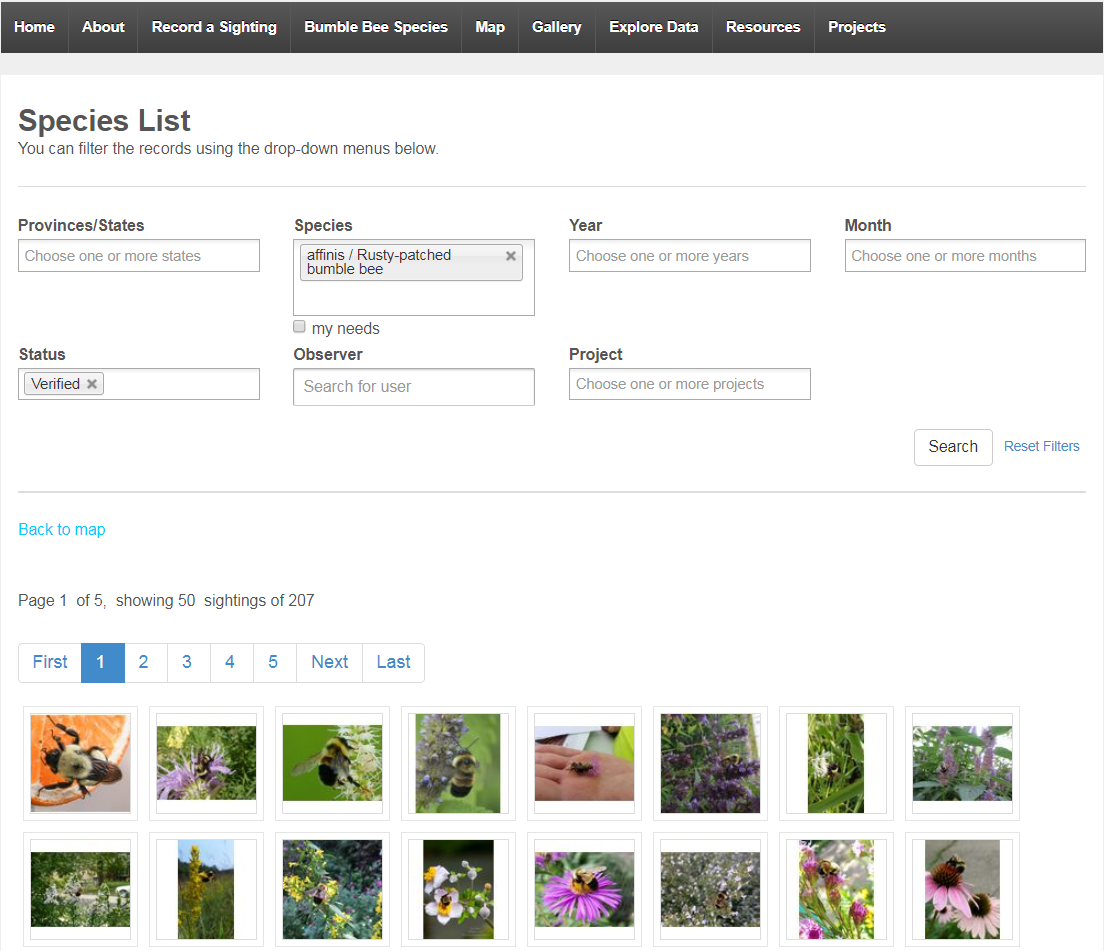There's a lot of enthusiasm for the project, with an overwhelming majority of users participating in order to contribute to scientific data collection.
This past February, Bumble Bee Watch (BBW) users were invited to take a survey run by York University researchers to learn more about participant demographics, motives, and confidence with bumble bee identification. The survey had 342 respondents across Canada and the United States, representing members of various ages, locations, and years of participation. Early results are now in, and there are some interesting findings regarding why people get involved, how their skills and awareness have changed, and their thoughts program improvements and aspects that are working well.
Why do people join and stay involved with BBW? An overwhelming majority of respondents participate in BBW to contribute to scientific data collection (88%), and because they are worried about bees and want to help save them (83%). More than half participate to learn more about species on their property (63%) and region (56%), or because they have a personal interest in bumble bees (59%). Most individuals have other identification skills or interests, with birds, plants, and butterflies and moths being the top three groups reported. About half are also involved with an organization such as a gardening group, nature club, entomological society, birding group, or wildlife federation.
While there is a lot of enthusiasm for the project, 84% of respondents only rarely or sometimes submit photos, and 69% have submitted less than 10 observations in total. However, BBW increased awareness of the diversity of bumble bee species in 77% of participants, and 84% report improvement in their identification skills as a result of participation.

Participants also told us what they liked best about the program, and there was a lot. Example feedback included:
“Being able to contribute to data and learn about Bumblebees. The App is nice too! I also feel hopeful that there is more of a connection between science and laypeople.”
“Ease of use and friendly design, ability to see records from everyday people instead of just scientists, and how it’s helped find rare species.”
“Feeling like I contributed. I noticed that the USFWS must pull data from BBW because the range map for RPBBs in my town is clearly based on my sightings.”
“I enjoy keying out the bees and having my answers confirmed and learning what bees are in my area.”
“I like seeing where others have made sightings of bees.”
“The expert confirmations are great. I like seeing the sightings maps to give me an idea of where else the species has been seen, the sightings maps also help tell me where and how much observer effort goes (so if I wanted I could try to fill in ‘gaps’).”
“It is educational and fun. My kids really enjoy it.”
“What’s not to like! I’ve learned a lot, I love the fact that it’s contributing to citizen science and grows public awareness. Plus it’s fun. I wish I had a better camera though.”
What we’re taking from the survey:
- Faster photo identification (verification): We are working on ways to speed turnaround time between submitting an observation and getting it verified. We are now getting individuals such as summer research field assistants, who have more training and experience in identifying bees in specific regions, to help verify the more easily distinguishable species. We are also launching a new Bumble Bee Enthusiast level, where knowledgeable members of the public can provide feedback on images.
- Photos to complement the identification diagrams during the submission process: While there is not currently a way to view photos of each species on the identification key screen, there are thousands of images in our photo gallery. By opening up a separate browser tab or window, opening up the gallery option, selecting the species you are interested in, and choosing the “verified” option, you can see if your mystery bee resembles the species you have narrowed it down to.
- Localized identification resources: We are discussing regional guides, which are already available in some areas. But users from across Canada and the United States can use the map view on the website to see what species have been verified in their province or state. Simply select your province or state, ensure “verified” is listed for the status, and color code by species (rather than by status). Each species will appear as a different color on the map, with a legend underneath the map listing all of the species next to their color dot.
- A more user-friendly website: We are continually working to improve the website, adding new features in response to feedback from users. If you have not been on the website recently, log in today!
- An app for smartphones and other devices: We launched an iOS app for iPhones, iPads, and iPods last summer, which can be downloaded from the App Store. We are currently beta testing one for Android devices and hope to have it launched soon: stay tuned for updates!
- Increased communications and reporting: Follow us on Facebook and Twitter or sign up for our enewsletter to get tips about BBW and learn more about how we’re using data from our users to help us better protect bumble bees.
Thanks to everyone who participated in our survey, and thanks to everyone who has submitted even one observation to our site. With the 2018 bumble bee season now underway, keep your eyes open and your camera handy, and help us continue to expand our knowledge of bumble bees across Canada and the United States. Remember, you can submit your observations from both past and the current year now at www.bumblebeewatch.org!





